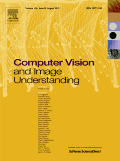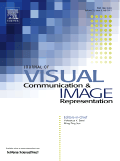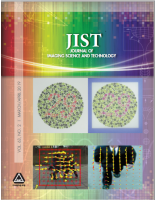
Image Processing On Line
Scope & Guideline
Bridging theory and practice in a dynamic digital environment.
Introduction
Aims and Scopes
- Image Restoration and Enhancement:
The journal frequently publishes research on techniques for improving image quality, including denoising, deblurring, and color correction, utilizing advanced algorithms and methodologies. - Image Segmentation and Analysis:
A significant focus is on methods for segmenting images into meaningful regions, including interactive segmentation approaches and deep learning techniques for semantic segmentation. - Image Forgery Detection and Forensics:
Research on detecting and analyzing image forgery has been a consistent theme, employing various forensic techniques to ensure image integrity. - Computer Vision Applications:
The journal covers a wide range of applications in computer vision, including depth estimation, object detection, and scene understanding, often integrating machine learning techniques. - Signal Processing Techniques for Imaging:
Innovative signal processing methods for enhancing and analyzing image data are a core area, highlighting the intersection of image processing and signal processing. - Theoretical Developments in Image Processing:
The journal also emphasizes theoretical advancements, exploring new algorithms and mathematical models that underpin image processing techniques.
Trending and Emerging
- Deep Learning Applications in Image Processing:
There is a significant uptick in research utilizing deep learning frameworks for various image processing tasks, including segmentation, restoration, and enhancement, indicating a trend towards more data-driven approaches. - Interactive and User-Centric Image Processing:
Emerging themes in interactive image segmentation and user-guided methods highlight a growing interest in making image processing more accessible and intuitive for users. - Robustness in Image Analysis:
Recent works emphasize the robustness of algorithms in real-world applications, addressing challenges such as noise and variability in data, which is becoming increasingly important in practical implementations. - Integration of Image Processing with Other Domains:
There is a trend towards interdisciplinary research that combines image processing with fields such as medical imaging, remote sensing, and machine learning, expanding the scope and impact of image processing techniques. - Real-Time Image Processing Techniques:
The rise of applications requiring real-time processing, such as autonomous vehicles and augmented reality, has led to an increase in research focused on optimizing algorithms for speed and efficiency.
Declining or Waning
- Traditional Image Processing Techniques:
There has been a noticeable decline in papers focusing on classical image processing methods, such as basic filtering and histogram-based techniques, as more advanced computational methods gain traction. - 3D Imaging and Reconstruction:
Research on 3D imaging techniques, while still relevant, has seen a decrease in frequency, possibly due to the increasing popularity of 2D image analysis and deep learning approaches. - Basic Statistical Methods for Image Analysis:
The application of fundamental statistical methods in image analysis appears to be waning, as the field shifts towards more complex, data-driven approaches utilizing machine learning.
Similar Journals

VISUAL COMPUTER
Shaping Tomorrow’s Visual Technologies TodayVISUAL COMPUTER is a prestigious journal published by Springer, focusing on the dynamic fields of computer graphics, computer-aided design, computer vision, and software. Established in 1985, this interdisciplinary journal serves as a vital platform for sharing innovative research, applications, and developments crucial to the advancement of visual computing technologies. With a notable Q2 ranking in various categories, including Computer Graphics and Computer-Aided Design, and Computer Vision and Pattern Recognition, VISUAL COMPUTER demonstrates a solid impact within the academic community, marked by its Scopus rankings that reflect its significant contributions to the field. While the journal does not offer open access, it remains a reliable source of high-quality content for researchers, professionals, and students eager to stay abreast of emerging trends and techniques, ultimately fostering collaboration and knowledge exchange within the rapidly evolving landscape of visual computing.

Traitement du Signal
Connecting Ideas, Advancing EngineeringTraitement du Signal, published by the INT Information & Engineering Technology Association, is a distinguished journal that serves the vibrant field of Electrical and Electronic Engineering. With an ISSN of 0765-0019 and an E-ISSN of 1958-5608, this journal has made significant contributions to the discipline since its inception. While it currently operates under a non-open access model, it maintains its commitment to disseminating valuable research from 2010 to 2023, despite its recent discontinuation in Scopus coverage. Recognized in the third quartile (Q3) of the category in 2022, the journal provides a platform for researchers, professionals, and students to publish their findings on topics such as signal processing, communications, and related technologies. By curating high-quality articles, Traitement du Signal plays a crucial role in advancing knowledge and fostering innovation within the electrical and electronic engineering community.

Journal of Real-Time Image Processing
Exploring the Dynamics of Real-Time Visual TechnologiesJournal of Real-Time Image Processing, published by SPRINGER HEIDELBERG, is a renowned peer-reviewed journal dedicated to the field of real-time image processing. With an ISSN of 1861-8200 and an E-ISSN of 1861-8219, this journal operates under a rigorous academic framework, ensuring high-quality publications that cater to both theoretical and practical advancements in the discipline. Since its inception in 2006, it has continually evolved, maintaining a Q2 ranking in Information Systems according to the 2023 Category Quartiles. This journal ranks #103 out of 394 in Scopus for Computer Science - Information Systems, positioning it within the top 27% percentile, which underscores its significance in the research community. Its focus on the intersection of image processing and real-time applications makes it a vital resource for researchers, professionals, and students eager to explore and contribute to cutting-edge developments in the field. Though it does not currently offer open access, the journal's comprehensive scope and commitment to disseminating impactful research make it an essential platform for advancing knowledge in real-time image processing.

COMPUTER VISION AND IMAGE UNDERSTANDING
Unveiling the Future of Image AnalysisCOMPUTER VISION AND IMAGE UNDERSTANDING is a leading academic journal published by Academic Press Inc, Elsevier Science, dedicated to the advancement of the fields of computer vision, image understanding, and pattern recognition. Since its inception in 1993, this esteemed publication has garnered a reputation for excellence, achieving a remarkable Q1 ranking in the categories of Computer Vision and Pattern Recognition, Signal Processing, and Software as of 2023. With its robust impact factor and high visibility in the scientific community—ranking #22 out of 106 in Computer Vision and Pattern Recognition and #27 out of 131 in Signal Processing—this journal serves as a vital resource for researchers, professionals, and students looking to explore and contribute to state-of-the-art developments. Although it does not operate under an Open Access model, its rigorous peer-reviewed content ensures quality and relevance in a rapidly evolving technological landscape. The journal’s commitment to fostering innovation makes it an essential tool for anyone engaged in the study and application of computer vision technologies.

EURASIP Journal on Image and Video Processing
Transforming Ideas into Visual RealitiesEURASIP Journal on Image and Video Processing, published by Springer, is a leading open-access journal dedicated to the dissemination of significant advancements in the field of image and video processing. Since its inception in 2007, the journal has been pivotal in bridging the gap between theoretical research and practical applications, serving a diverse audience of researchers, professionals, and students. With an impressive impact factor reflected in its 2023 Scopus rankings—ranking Q2 in Electrical and Electronic Engineering, Information Systems, and Signal Processing—this journal showcases innovative methodologies, applications, and technologies in the realm of image and video processing. Authors benefit from the journal's open-access model, promoting widespread visibility and accessibility of their work. Located in the heart of New York City, the journal continues to evolve, covering converged years from 2007 to 2024, ensuring it remains at the forefront of research in a rapidly changing technological landscape.

SIGNAL PROCESSING-IMAGE COMMUNICATION
Innovating Signal Processing for Tomorrow's TechnologiesSIGNAL PROCESSING-IMAGE COMMUNICATION, published by Elsevier, is a leading journal in the fields of Computer Vision, Signal Processing, and Electrical Engineering. With an impressive range of Quartile rankings in 2023, including Q1 in Electrical and Electronic Engineering and Q2 in Signal Processing, this journal is vital for researchers and professionals seeking the latest advancements and comprehensive studies in image communication technologies. Issued in the Netherlands, SIGNAL PROCESSING-IMAGE COMMUNICATION has been an essential resource since its inception in 1989, fostering innovation and collaboration among academia and industry. The journal provides a platform for high-quality peer-reviewed research, addressing significant challenges and solutions in the convergence of image processing and communication. Although currently not an Open Access journal, it offers subscription options that ensure a broad dissemination of groundbreaking knowledge. With a robust reputation reflected in its Scopus ranks, this journal serves as an indispensable reference for students and experts aiming to stay at the forefront of developments in this dynamic field.

Journal of Imaging
Exploring New Frontiers in Imaging ResearchThe Journal of Imaging, published by MDPI, is an esteemed open-access journal dedicated to advancing the fields of Computer Graphics, Computer Vision, and Electrical Engineering. Since its inception in 2015, this journal has established a significant presence in the academic community, reflected by its impressive rankings in Scopus, including a Q2 quartile in multiple categories such as Computer Vision and Pattern Recognition and Radiology. With a commitment to disseminating high-quality research, the journal offers a platform for innovative studies and practical applications, making it an essential resource for researchers, professionals, and students alike. Operating from its base in Basel, Switzerland, the journal continues to promote scholarly work that pushes the boundaries of imaging technologies, while contributing to the global discourse in its respective fields. The open-access model ensures that valuable research is readily available, fostering collaboration and knowledge-sharing across disciplines.

JOURNAL OF VISUAL COMMUNICATION AND IMAGE REPRESENTATION
Exploring the Art and Science of Image RepresentationJOURNAL OF VISUAL COMMUNICATION AND IMAGE REPRESENTATION, published by Academic Press Inc Elsevier Science, is an influential platform dedicated to the realms of visual communication, media technology, and advanced image representation. With a strong focus on interdisciplinary approaches, this journal aims to foster the exchange of innovative ideas among researchers and professionals in the fields of computer vision, image processing, and signal processing. Recognized for its significance, it boasts an impressive impact factor within its category quartiles; notably, it ranks Q2 in Computer Vision and Pattern Recognition and Electrical and Electronic Engineering, while achieving Q1 in Media Technology. Based in the United States, the journal not only provides valuable insights into the latest developments from 1990 to 2024 but also encourages cutting-edge research that enhances multimedia systems and user interactions. As a vital resource for students, researchers, and industry professionals alike, the journal ensures a robust understanding of visual information processing, critical for navigating today's digital landscape.

International Journal of Biomedical Imaging
Bridging Technology and Clinical InsightInternational Journal of Biomedical Imaging, published by HINDAWI LTD, stands as a pivotal resource in the field of biomedical imaging, bridging the gap between technological innovation and clinical application. Since its inception in 2006 as an Open Access journal, it has become accessible to a global audience, facilitating research dissemination and collaboration. The journal has garnered recognition within the academic community, achieving a notable Q2 category ranking in Radiology, Nuclear Medicine, and Imaging, with an impressive Scopus rank of 16 out of 333, placing it in the 95th percentile of its field. With coverage from 2006 to 2024, the journal encompasses a broad spectrum of studies focused on advancements in imaging technologies, methodologies, and clinical applications, making it an indispensable source for researchers, professionals, and students eager to stay at the forefront of biomedical imaging innovation.

JOURNAL OF IMAGING SCIENCE AND TECHNOLOGY
Illuminating Innovations in Imaging TechnologiesJOURNAL OF IMAGING SCIENCE AND TECHNOLOGY, published by I S & T - SOC IMAGING SCIENCE TECHNOLOGY, is a pivotal resource in the realms of imaging science, optics, and materials. With its ISSN 1062-3701 and E-ISSN 1943-3522, this journal has been disseminating influential research since 1993 and continues to be a vital platform for scholars up to 2024. Despite its varied quartile rankings across disciplines—such as Q4 in Atomic and Molecular Physics and Optics, and Q3 in Chemistry (Miscellaneous) and Electronic, Optical and Magnetic Materials—it provides an essential forum for innovative ideas and advancements. The journal’s focus on interdisciplinary connections encourages collaboration among researchers in the fields of chemistry, computer science, and physics. Researchers, professionals, and students interested in exploring the latest imaging technologies and methodologies will find invaluable insights within its pages, making it a significant addition to their academic libraries.